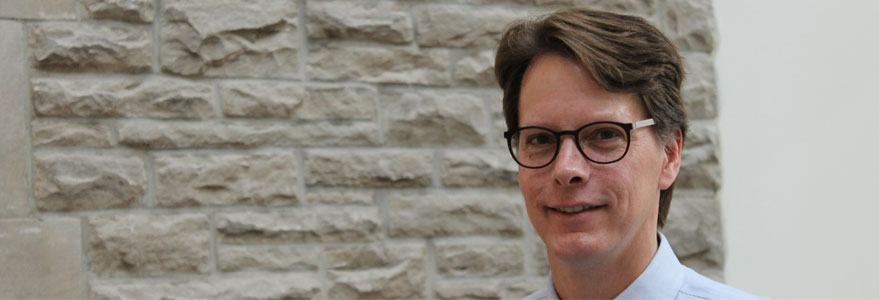News and Updates
Contact
Faculty of Social Science
Social Science Centre
Room 9438
Western University
T. 519-661-2053
F. 519-661-3868
E. social-science@uwo.ca
CIHR grant supports research of motor learning by observing
January 31, 2018
Story and photo by Rob Rombouts
Can you learn by watching? Paul Gribble thinks so.
Gribble, Professor joint-appointed in the Department of Psychology and the Department of Physiology & Pharmacology, and member of the Brain and Mind Institute, has received a CIHR grant to research sensory motor neuroplasticity and motor learning by observing.
The grant will allow Gribble to build on previous research and deepen the understanding of how the brain reacts to watching others perform an action.
“It’s intriguing,” said Gribble. “When you watch someone else moving, or learning new motor skills, the parts of the brain that are normally active when you are learning, are also active.”
In his lab, Gribble asks subjects to move a robotic arm to touch an on screen target. As they move the arm, they face different levels of counterforce, causing them to change the necessary applied force. This changes the mapping between motor commands and the movement of the arm, and over time, people learn how to reshape motor commands to compensate for the robot force, and complete the task.
In the second phase, new subjects were shown videos, of the first subjects learning to reach using the robot arm. They were then asked to use the robotic arm. The results show that subjects who watched a video of someone else using the arm started roughly 20 per cent farther down the learning curve than those that did not.
Along with that, FMRI scans reveal the changes in the brain that underlie observational learning. The primary motor cortex, the last stop in the brain before motor commands are sent to the spine and to muscles, and the somatosensory cortex (the part of the brain that receives signals from the body), show changes in activity during observation—changes that can be linked to behavioural measures of learning from observing.
On the theoretical side, this represents a new way to think about how motor learning can occur.
“There is some common sense to this,” said Gribble. “When you want to learn something, you watch someone else do it, but many theoretical models of motor skill learning don’t include this idea.”
Gribble said the research could provide new basic knowledge that could someday lead to new treatment options for clinicians. “If some parts of motor skills can be primed through observation, this may provide a back door to neuroplasticity, for diseases affecting movement such as stroke,” said Gribble.
The basic science approach is important for CIHR to support, Gribble said.
“Of course applied and clinical research is important. But basic research provides the foundation for clinical advances—basic research is acquiring new knowledge,” said Gribble. “Without funding basic research, it is like we are saying we know everything. It is often the case that exciting new clinical advances come from exciting new basic research.”
Along with expanding the basic understanding of the brain, the grant will help expand the research capacity in the field.
“The main thing the grant will enable me to do will be to hire new skilled researchers and trainees,” said Gribble. “They will be trained, not just to be professors, but to go into the workforce with research skills.”

